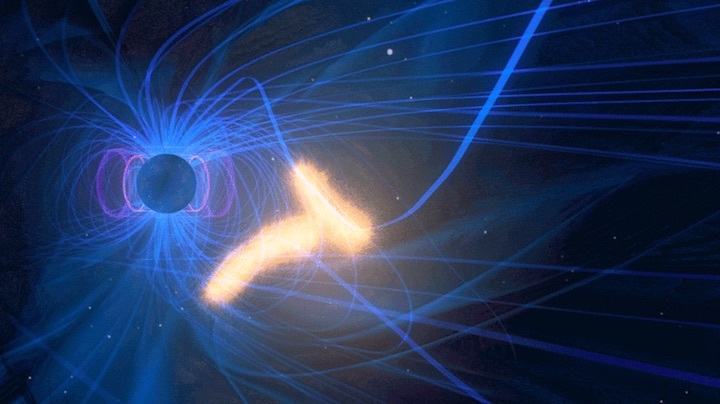13.03.2020

Since its launch on March 12, 2015, NASA’s Magnetospheric Multiscale Mission, or MMS, has been making new discoveries as it flies around Earth studying magnetic reconnection — the explosive snapping and forging of magnetic field lines, at the heart of space weather storms that manifest around Earth. In its first year, MMS’s state-of-the-art design broke records — and it hasn’t stopped excelling since.
The mission uses four identical spacecraft flying in a pyramid-shape to measure magnetic field lines and charged particles in three-dimensions. In 2016 their trajectory won the spacecraft a Guinness World record for highest altitude fix of a GPS — 43,500 miles above the surface (which it later smashed with a fix at 116,300 miles). Additionally, when the satellites are closest to Earth, they move at up to 22,000 miles per hour, making them the fastest known operational use of a GPS receiver.
But it’s not just about breaking flight records. MMS has made pivotal scientific discoveries that are helping scientists understand the Earth’s magnetic environment — its magnetosphere — and magnetic reconnection, which powers magnetic storms around Earth and sparks the auroras. Here are five ways MMS has changed our understanding of these explosive events in our near-Earth space in the past five years.
1) How Magnetic Reconnection Works
Determining the details of how magnetic reconnection works was one of the key jobs MMS was tasked with — and the mission soon delivered. Before MMS, scientists didn’t truly understand the specifics of how magnetic reconnection works, they only had general ideas. But MMS quickly changed that. Mission observations determined which of several 50-year-old theories about magnetic reconnection were correct and further showed how the physics of electrons dominates the process, which had not been predicted. Much of the discovery was driven by MMS’s innovative instrument design. “We increased MMS’s instrument measuring speeds 100 times from previous instruments,” said Jim Burch, principal investigator for MMS at the Southwest Research Institute in San Antonio, Texas. “It’s allowed us to see things no one had been able to measure before MMS.”
2) Reconnection in Surprising New Places
In the five years after launch, MMS made over a thousand trips around Earth, passing through countless magnetic reconnection events. It saw magnetic reconnection where scientists first expected it, behind the Earth, away from the Sun — and it discovered magnetic reconnection in several new places. Completely surprising scientists, MMS has seen events in turbulent regions in front of Earth that were previously expected to be too tumultuous for magnetic reconnection. It has also observed magnetic reconnection in magnetic flux ropes — giant magnetic tubes, which can form in the wake of previous magnetic reconnection events, and in Kelvin-Helmholtz vortices, the same phenomenon that are created when wind blows over water to create waves on the surface.
3) Transferring Energy
MMS scientists discovered the ways energy is transferred via magnetic reconnection and at what rate, in part because of the spacecrafts’ tight flying formation — just 4.5 miles between them, the closest of any spacecraft ever flown — which allows scientists to study small-scale details unobservable by previous missions. One energy transfer mechanism was discovered in 2017 when scientists uncovered complex electron motions in the thin layers of electrical current where reconnection happens. The unique dances electrons made in this region allowed them to gain additional energy and accelerate the reconnection process.
4) Computer Simulations
Before MMS, computer simulations were the best tool scientists had to understand magnetic reconnection. The models were a way to fill in the gaps between measurements made across large distances as captured by previous space missions. But thanks to MMS’s detailed measurements, the scales flipped. Today MMS’s high resolution data has uncovered a myriad of electron-scale physics that the computer simulations are now rushing to accurately represent. Having such detailed data has allowed theoretical physicists to further refine their models and understand the specific mechanisms behind magnetic reconnection better than ever before.
5) Insights into Astrophysics and Nuclear Physics
MMS has opened a unique space laboratory where all scales of magnetic reconnection can be directly measured by the spacecraft as they fly through ongoing events. This has allowed new insights into magnetic reconnection in other regions of space, including explosions on the Sun and in supernovae and black holes.
“MMS’s measurements are critical because we can understand how magnetic reconnection happens in other places, even though we can’t get there,” said Kevin Genestreti, MMS research scientist at the Southwest Research Institute’s Earth, Oceans and Space Department at the University of New Hampshire in Durham. MMS has also given insight into nuclear experiments on Earth. The plasma — that is, the hot, charged gases — used in nuclear experiments is the same state of matter that MMS flies through as it travels through space. Magnetic reconnection, which happens often within plasma, poses a challenge for scientists wanting to confine plasma in nuclear experiments. The information garnered by MMS is helping scientists better understand and potentially control magnetic reconnection, which may lead to improved nuclear fusion techniques to generate energy more efficiently.
MMS was originally launched for a two-year prime mission, and after its early successes it was extended an additional three years. Due to careful maneuvering during flight operations, MMS should have enough fuel to last it at least another two decades.
“MMS has well over 100 instrument components,” said Barbara Giles, MMS senior project scientist at NASA’s Goddard Space Flight Center in Greenbelt, Maryland. “We’re five years in and this mission is still just as capable as when it launched.”
To date, MMS data has been used in over 580 scientific papers. MMS has also launched early career scientists and contributed to 14 PhD theses and 10 master’s theses. Outreach at schools, museums, conferences and other events has also directly reached 120,000 people. MMS scientists are confident the spacecraft’s data will continue to fuel new discoveries for decades to come.
Quelle: NASA


